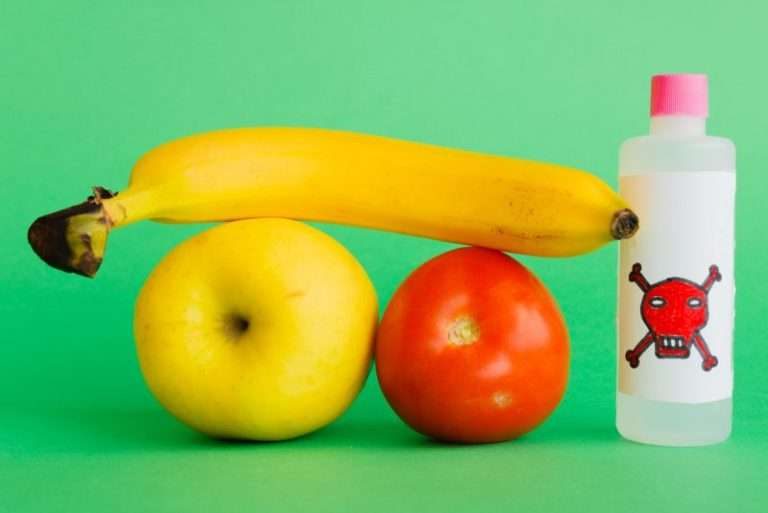How often do you eat fruits or vegetables? Have you wondered how much exposure is there to pesticides? How do we remove pesticides, if they were indeed exposed and have residues of pesticides?
If you don’t take the time to wash them before consuming them, they can contain synthetic pesticide residues. These residues are harmful to humans over long-term exposure to pesticides.
Pesticides are chemicals that kill pests such as insects, weeds, rodents, and other animals. They are widely used in agriculture because they are effective at controlling crop damage and disease. Pesticide residues are found on food crops grown using conventional farming methods. This is primarily because of the use of pesticides in mainstream farming and the levels of pesticide residues vary and there is no standard on the amounts of pesticide residues you can find on the produce
Organic Produce is an option people choose to avoid exposure to pesticides but these days there are residues in air, land, and water. This means that the organic foods themselves can have pesticide exposure, though not directly.
There are several ways to accomplish the removal of pesticide residues from fruits and vegetables. The easiest way is to rinse them thoroughly under running water. This removes surface dirt and debris. Another option is to soak the produce in a solution containing vinegar or lemon juice. Vinegar has natural antibacterial properties that can destroy harmful bacteria. Lemon juice contains citric acid, which helps preserve freshness.
Give it a Saltwater Soak
There are many ways to remove pesticide residues from fruit and vegetables, including soaking them in salt water. The idea behind this method is that the salt will absorb the chemicals and then rinse off easily.
To perform this method, place the fruits and vegetables in a large bowl and cover them with cold plain water. Add 1 tablespoon of salt per quart of water. Let the mixture sit overnight, then drain and rinse thoroughly, now the fruits and vegetables will no longer have much trace of pesticides.
Soak it in Vinegar
White Vinegar has many uses, including cleaning, cooking, and preserving food. It’s also used to clean surfaces and kill bacteria. Vinegar is a natural disinfectant, so it’s perfect for killing germs on fruit and veggies.
To remove pesticide residues from fruit and vegetables, soak them in a mixture of water and white distilled vinegar. The acidity in the vinegar will break down the chemicals, leaving behind a safe and healthy treat.
Clean it With Baking Soda and Water
Baking soda has many uses, including cleaning, deodorizing, and making homemade laundry detergent. It’s also used to clean fruit and vegetables that have been sprayed with pesticides.
To remove pesticide residues from fruits and vegetables, mix baking soda and water together in a bowl. Then soak the food in the mixture overnight. The next day, rinse off the baking soda and water mixture with cold water. Repeat this process until the residue disappears.
Wash it With Just Cold Water
Put the fruit or vegetable into a colander and hold it under running water. This method removes more pesticides than simply dipping the fruits and vegetables into water or simply washing it.
A study by the Environmental Working Group found that this method was much better at removing pesticide residue than washing fruits and vegetables in tap water.
Peel fruits and vegetables to remove pesticide residues.
Peeling fruit and vegetables removes pesticides that are used to protect the food against insects. Peeling also reduces the amount of surface area exposed to air, thereby decreasing exposure to bacteria and other contaminants.
However, peeling does not eliminate all pesticide residue. In fact, peeling may increase the amount of pesticide residue left on the skin. To minimize this potential problem, wash your hands thoroughly after peeling.
Using UltraSonic Cleaner
Untrasonic soak is an effective method to remove pesticide residues from produce.
It uses sound waves to break down the pesticide residue into harmless substances. Although there isn’t substantial evidence that pesticides are indeed removed. More research is required.
You can explore some products below if you feel like giving ultrasonic cleaning a try.
In conclusion, pesticide residue is a common problem that affects the food we eat. While it’s true that organic produce is generally healthier than its non-organic counterpart, it doesn’t mean that it’s completely free from pesticide contamination. In fact, it’s estimated that over 90% of fruits and vegetables sold in grocery stores contain traces of pesticides.
The good news is that there are several simple steps you can take to remove these residues without having to buy expensive equipment. For example, washing your fruit and veggies under cold water helps to reduce the amount of pesticide residue that ends up clinging to their surfaces. Another option is to use baking soda instead of soap when cleaning your produce. This method works because it neutralizes the acidity of the soap, which prevents it from breaking down the pesticides.
While these methods won’t eliminate all traces of pesticides, they can help to reduce the amount that ends up lingering on your produce. So next time you’re planning to buy some fresh fruits and veggies, keep these tips in mind and you’ll be able to enjoy them guilt-free!

